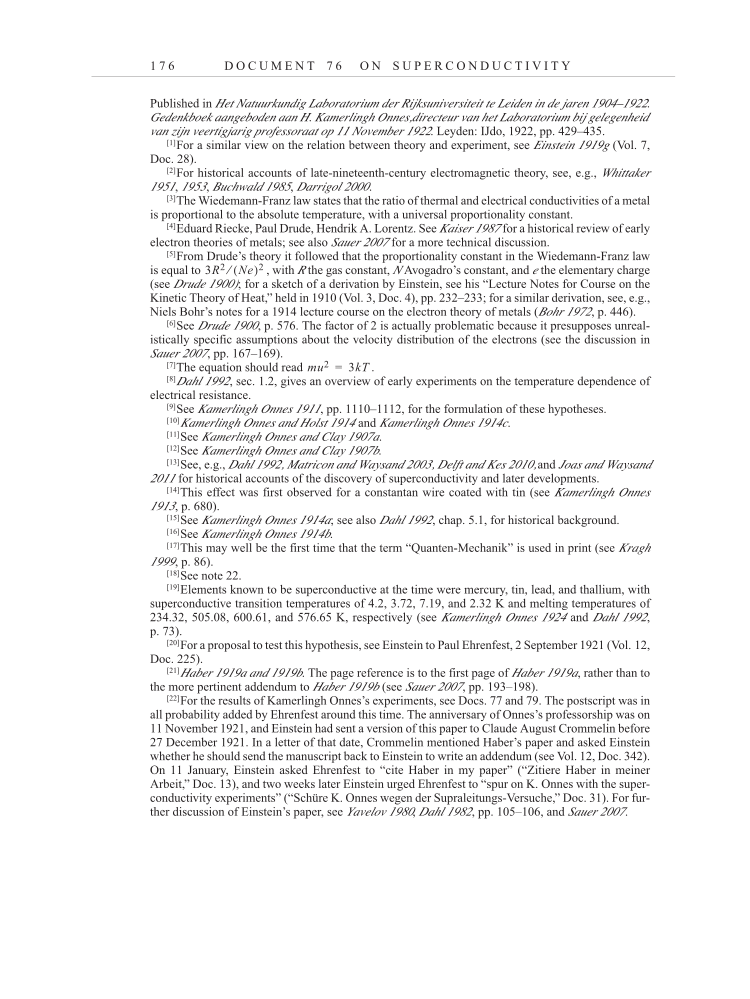1 7 6 D O C U M E N T 7 6 O N S U P E R C O N D U C T I V I T Y Published in Het Natuurkundig Laboratorium der Rijksuniversiteit te Leiden in de jaren 1904–1922. Gedenkboek aangeboden aan H. Kamerlingh Onnes,directeur van het Laboratorium bij gelegenheid van zijn veertigjarig professoraat op 11 November 1922. Leyden: IJdo, 1922, pp. 429–435. [1]For a similar view on the relation between theory and experiment, see Einstein 1919g (Vol. 7, Doc. 28). [2]For historical accounts of late-nineteenth-century electromagnetic theory, see, e.g., Whittaker 1951, 1953, Buchwald 1985, Darrigol 2000. [3]The Wiedemann-Franz law states that the ratio of thermal and electrical conductivities of a metal is proportional to the absolute temperature, with a universal proportionality constant. [4]Eduard Riecke, Paul Drude, Hendrik A. Lorentz. See Kaiser 1987 for a historical review of early electron theories of metals see also Sauer 2007 for a more technical discussion. [5]From Drude’s theory it followed that the proportionality constant in the Wiedemann-Franz law is equal to , with R the gas constant, N Avogadro’s constant, and e the elementary charge (see Drude 1900) for a sketch of a derivation by Einstein, see his “Lecture Notes for Course on the Kinetic Theory of Heat,” held in 1910 (Vol. 3, Doc. 4), pp. 232–233 for a similar derivation, see, e.g., Niels Bohr’s notes for a 1914 lecture course on the electron theory of metals (Bohr 1972, p. 446). [6]See Drude 1900, p. 576. The factor of 2 is actually problematic because it presupposes unreal- istically specific assumptions about the velocity distribution of the electrons (see the discussion in Sauer 2007, pp. 167–169). [7]The equation should read . [8]Dahl 1992, sec. 1.2, gives an overview of early experiments on the temperature dependence of electrical resistance. [9]See Kamerlingh Onnes 1911, pp. 1110–1112, for the formulation of these hypotheses. [10]Kamerlingh Onnes and Holst 1914 and Kamerlingh Onnes 1914c. [11]See Kamerlingh Onnes and Clay 1907a. [12]See Kamerlingh Onnes and Clay 1907b. [13]See, e.g., Dahl 1992, Matricon and Waysand 2003, Delft and Kes 2010, and Joas and Waysand 2011 for historical accounts of the discovery of superconductivity and later developments. [14]This effect was first observed for a constantan wire coated with tin (see Kamerlingh Onnes 1913, p. 680). [15]See Kamerlingh Onnes 1914a see also Dahl 1992, chap. 5.1, for historical background. [16]See Kamerlingh Onnes 1914b. [17]This may well be the first time that the term “Quanten-Mechanik” is used in print (see Kragh 1999, p. 86). [18]See note 22. [19]Elements known to be superconductive at the time were mercury, tin, lead, and thallium, with superconductive transition temperatures of 4.2, 3.72, 7.19, and 2.32 K and melting temperatures of 234.32, 505.08, 600.61, and 576.65 K, respectively (see Kamerlingh Onnes 1924 and Dahl 1992, p. 73). [20]For a proposal to test this hypothesis, see Einstein to Paul Ehrenfest, 2 September 1921 (Vol. 12, Doc. 225). [21]Haber 1919a and 1919b. The page reference is to the first page of Haber 1919a, rather than to the more pertinent addendum to Haber 1919b (see Sauer 2007, pp. 193–198). [22]For the results of Kamerlingh Onnes’s experiments, see Docs. 77 and 79. The postscript was in all probability added by Ehrenfest around this time. The anniversary of Onnes’s professorship was on 11 November 1921, and Einstein had sent a version of this paper to Claude August Crommelin before 27 December 1921. In a letter of that date, Crommelin mentioned Haber’s paper and asked Einstein whether he should send the manuscript back to Einstein to write an addendum (see Vol. 12, Doc. 342). On 11 January, Einstein asked Ehrenfest to “cite Haber in my paper” (“Zitiere Haber in meiner Arbeit,” Doc. 13), and two weeks later Einstein urged Ehrenfest to “spur on K. Onnes with the super- conductivity experiments” (“Schüre K. Onnes wegen der Supraleitungs-Versuche,” Doc. 31). For fur- ther discussion of Einstein’s paper, see Yavelov 1980, Dahl 1982, pp. 105–106, and Sauer 2007. 3R2 Ne)2 ( ⁄ mu2 3kT =
